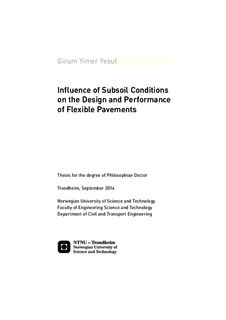| dc.contributor.advisor | Hoff, Inge | nb_NO |
| dc.contributor.advisor | Vaslestad, Jan | nb_NO |
| dc.contributor.author | Yesuf, Girum Yimer | nb_NO |
| dc.date.accessioned | 2014-12-19T11:35:14Z | |
| dc.date.available | 2014-12-19T11:35:14Z | |
| dc.date.created | 2014-10-15 | nb_NO |
| dc.date.issued | 2014 | nb_NO |
| dc.identifier | 755912 | nb_NO |
| dc.identifier.isbn | 978-82-326-0450-0 (printed ver.) | nb_NO |
| dc.identifier.isbn | 978-82-326-0451-7 (electronic ver.) | nb_NO |
| dc.identifier.uri | http://hdl.handle.net/11250/233254 | |
| dc.description.abstract | The effect of subsoil conditions is one of the prominent factors that control both the design and performance of flexible pavement structures. Despite having a wide range of empirical methods from measurements and experience, the quantification of the short-term and long-term physical processes of geo-materials in roads is not yet fully understood. Particularly, subgrade soils have not got the required attention in the characterization of pavement materials although they are known as the “foundation” of the pavement structure. This conception has raised — partly due to the notion that the stress from the traffic is low at the subgrade level — and partly, due to existence of a wide variety of soils, in contrast to standardized materials for asphalt, base, and sub-base layers. Lowtraffic volume roads, however, have often thin asphalt layer, and the stress magnitude from the traffic loads can be significant at the subgrade level. In addition, subgrade soils are most susceptible to the variation of local and environmental conditions.
With the fact that the subgrade layer is an integral part of pavement analysis, this thesis aimed to address the main important issues of characterization of subgrade soils in mechanistic pavement design methods. The objectives of this research have been classified within three main themes: (1) to propose numerical models to characterise subgrade soils for practical mechanistic-empirical pavement design method, (2) to enhance the quantitative characterisation of subgrade soils — instead of the widely used qualitative characterizations in practice, (3) to use finite element method to optimise road design and maintenance practices.
The main contributions of this study are: First, an overview of research literature is provided on the existing methods and knowledge of characterization of subgrade soils in flexible pavement design. The geotechnical aspects in pavement design are outlined to identify the research needs and to formulate the main research questions. Second, a method for formulation and implementation of a nonlinear resilient modulus model is presented. The method in this study has been found to be more versatile than the existing methods for characterization of subgrade soils since it considers the effects of both confining pressure and deviator stress. The implications of this method were found to be important aspects of pavement design for low-traffic volume roads.
Third, a constitutive model is proposed to predict the long-term deformation of subgrade soils. The model is formulated based on the plastic strain from first loading cycle, and an additional parameter that accounts for the proximity of the applied stress to the static strength of the soil. The predicted results from the proposed model showed a good agreement with laboratory tests for deviator stress level up to 50% of the static strength of the soil. Fourth, based on finite element modelling of soil compaction, the lift thickness of fine-grained soils has been observed to be defined as a function of cohesion and friction angle. This study suggested the optimisation technique of lift thickness depending on the strength parameters of soils to improve the rolling strategy of soil compaction during road construction.
Finally, a finite element modelling technique is presented for prediction of spring thawing in frozen subgrade soils. Since there are no well-established methods for modelling of the thawing process, analytical solutions are used to validate the numerical methods for simplified boundary conditions. Further, the application of finite element method is extended to model multi-layer pavement structures with the thermal and physical properties of each layer and varying surface temperature. In this study, the thaw depth is observed to be linearly proportional to time for sinusoidal surface temperature variation — in contrast to the existing knowledge of thaw rate for homogeneous frozen layers where the thaw depth is proportional to the square root of time. | nb_NO |
| dc.language | eng | nb_NO |
| dc.publisher | Norges teknisk-naturvitenskapelige universitet, Fakultet for ingeniørvitenskap og teknologi, Institutt for bygg, anlegg og transport | nb_NO |
| dc.relation.ispartofseries | Doktoravhandlinger ved NTNU, 1503-8181; 2014:269 | nb_NO |
| dc.relation.haspart | Yesuf, Girum Yimer; Hoff, Inge; Vaslestad, Jan. Development of excess pore-water pressure in thawing process of frozen subgrade soils. 18 th International Conference on Soil Mechanics and Geotechnical Engineering, 2013. | nb_NO |
| dc.relation.haspart | Yesuf, Girum Yimer; Hoff, Inge; Vaslestad, Jan. Optimization of Effective Depth of Compaction for Fine-Grained Soils. The Third International Conference on Geotechnique, Construction Materials and Environment: 333-338, 2013. | nb_NO |
| dc.title | Influence of Subsoil Conditionson the Design and Performance of Flexible Pavements | nb_NO |
| dc.type | Doctoral thesis | nb_NO |
| dc.contributor.department | Norges teknisk-naturvitenskapelige universitet, Fakultet for ingeniørvitenskap og teknologi, Institutt for bygg, anlegg og transport | nb_NO |
| dc.description.degree | PhD i bygg, anlegg og transport | nb_NO |
| dc.description.degree | PhD in Civil and Transport Engineering | en_GB |
